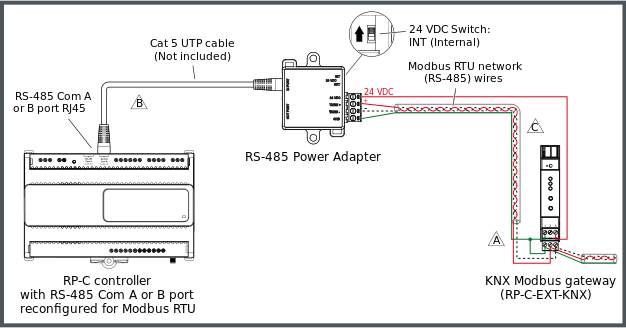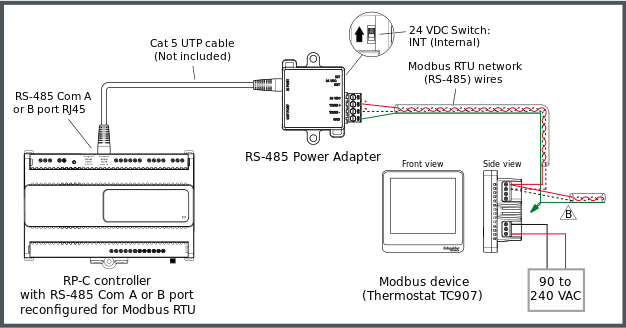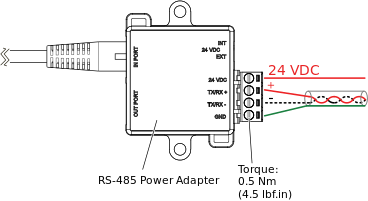The RS-485 Power Adapter can be used to convert a BACnet/IP controller (RP or MP controller) RS-485 interface from RJ45 port to screw terminals, which is required to be able to connect the controller to an RS-485 based network such as a Modbus RTU network. The types of RS-485-based networks supported differ between the different RP and MP controller models.
Through the RS-485 Power Adapter, 24 VDC can also be distributed from the BACnet/IP controller RS-485 interface to a device on the RS-485 bus.
|
Aviso
|
|
EQUIPMENT DAMAGE OR LOSS OF COMMUNICATION
Do not use the adapter to connect an MP or RP controller to a BACnet MS/TP (RS-485) bus for communication with an automation server.
Failure to follow these instructions can result in equipment damage or loss of communication.
|
You should not use the RS-485 Power Adapter to connect an MP or RP controller to a BACnet MS/TP (RS-485) network, even if there is nothing preventing you from physically connecting the adapter to such a network, as it can cause ground loops and poses a risk of miswiring of 24 VDC and bias terminals.
Examples
This section gives two examples of how the adapter can be used to convert an RP controller RS-485 interface:
Aviso
The RP controller Modbus network supports up to 10 connected Modbus devices with the following restrictions:
Example with an RP-C controller and a KNX Modbus gateway
The following figure shows an example of how an RS-485 Power Adapter is connected to one of the RS-485 Com ports (RJ45) of an RP-C controller via a Cat 5 (or higher) UTP cable and how the Modbus RTU network twisted pair wires from the adapter are connected to the screw terminals of a KNX Modbus gateway (RP-C-EXT-KNX), which is powered by the controller via the adapter. Additional Modbus devices may be daisy-chained from the KNX Modbus gateway.
Aviso
The twisted pair cable used for TX/RX+ and TX/RX- data wires extends in one direction from the adapter to each device in a daisy chain bus configuration without cable stubs.
Para obtener más información, consulte KNX Modbus Gateway Screw Terminals and Connector
.
action_zoom_plus_stroke

Figura:
Example with an RS-485 Power Adapter used for connection of an RP-C controller to a Modbus RTU network and a KNX Modbus gateway
action_zoom_plus_stroke

The twisted pair shielded cable should have the shield connected to ground only at (through) the RP-C controller. In the figure above, the shield drain wire at the end of the cable is connected to the KNX Modbus gateway and is not connected to ground at the remote location. When connected to multiple devices on the bus, the shield drain wire continues to the next device and remains isolated from additional ground connections.
action_zoom_plus_stroke

Using a Cat 5 UTP network patch cable, the connection from the RP-C controller to the RS-485 Power Adapter can extend up to the maximum 72 m (236 ft) distance to the adapter positioned at the KNX Modbus gateway. Alternatively, the RS-485 Power Adapter may be positioned close to the RP-C controller with a short patch cable used to connect the adapter to the controller. Multiconductor 22 AWG (0.34 mm²) cable with a twisted pair for the Modbus data pair is used to connect the RS-485 Power Adapter to the KNX Modbus gateway.
action_zoom_plus_stroke

The wire connecting to the screw terminals on the RS-485 Power Adapter could be a 22 AWG (0.34 mm²) twisted pair with a shield and a 22 AWG (0.34 mm²) wire for 24 VDC power. Alternatively, a 22 AWG (0.34 mm²) cable with two twisted pairs could be used, with one pair for the Modbus RS-485 data and one pair for the +24 VDC and supply ground. In both cases the twisted pair should be a low capacitance cable.
Para obtener más información, consulte
Cable Selection
. Maximum total length of Cat 5 UTP cable plus the 22 AWG (0.34 mm²) multiconductor cable is 72 m (236 ft).
Example with an RP-C controller and standard Modbus device(s)
The following figure shows an example of how the Modbus RTU network twisted pair wires from the adapter are connected to the screw terminals of a standard Modbus device, which is powered by a separate power supply. In this example, the Modbus device is a thermostat from the SpaceLogic Thermostat TC907 Series. Additional Modbus devices may be daisy-chained from the thermostat.
Aviso
The twisted pair cable used for TX/RX+ and TX/RX- data wires extends in one direction from the adapter to each device in a daisy chain bus configuration without cable stubs.
action_zoom_plus_stroke

Figura:
Example with an RS-485 Power Adapter used for connection of an RP-C controller to a Modbus RTU network and standard Modbus device(s)
action_zoom_plus_stroke

The twisted pair shielded cable should have the shield connected to ground only at (through) the RP-C controller. At each device, such as thermostat TC907, the shield drain wire from the incoming cable should be spliced to the shield drain wire of the outgoing cable and isolated from ground at each splice.
Connection of RJ45 Port to BACnet/IP Controller RS-485 Com Port
A separate connection cable is required to connect the RJ45 port on the RS-485 Power Adapter to the RS-485 Com port (RJ45) on the BACnet/IP controller (RP or MP controller). The cable is not included and needs to be purchased separately.
Use a Cat 5 (or higher) unshielded, straight-through wired cable with eight conductors (four twisted pairs) and RJ45 connectors. Use a cable with the wire size (cross-sectional area) 22 to 26 AWG (0.34 to 0.14 mm²), and a rating that meets the requirements of the target environment. For example, when devices are installed in a space that handles conditioned air or return air, the cables typically need to be plenum-rated.
|
Aviso
|
|
LOSS OF COMMUNICATION
Use a Cat 5 or higher unshielded twisted pair cable with eight conductors (four twisted pairs), a cross-sectional area of 22 to 26 AWG (0.34 to 0.14 mm
2
), and a rating that meets the requirements of the target environment.
Failure to follow these instructions can result in loss of communication.
|
|
Aviso
|
|
LOSS OF COMMUNICATION
Ensure that the total length of the RS-485 bus, from the controller to the end of the bus, does not exceed the following limit:
Failure to follow these instructions can result in loss of communication.
|
Para obtener más información, consulte Connecting an RS-485 Power Adapter to Convert a BACnet/IP Controller RS-485 Interface
.
Para obtener más información, consulte Communication Port Wiring
.
Para obtener más información, consulte RJ45 Pinout for the RS-485 Port(s) of the RP-C Controllers
.
Para obtener más información, consulte RJ45 Pinout for the RS-485 Port(s) of the RP-V Controllers
.
Para obtener más información, consulte RJ45 Pinout for the RS-485 Port of the MP-V Controller
.
Wiring of Screw Terminals for Connection to RS-485 Bus
The four screw terminals are wired and connected to an RS-485 bus as described in the following table.
Recommended screw tightening torque: 0.5 Nm (4.5 lbf.in)
Tabla: Screw Terminals, RS-485 Power Adapter, Connection to RS-485 Bus
|
Terminal
|
Usage
|
|
24 VDC
|
Connected only when a device on the RS-485 bus requires 24 VDC power supply from the RP or MP controller. For example, the KNX Modbus gateway (RP-C-EXT-KNX) can be powered by an RP controller. Not connected in all other cases.
|
|
TX/RX+
|
Data line (+) for connection to the TX/RX+ signal in the RS-485 twisted pair connecting all devices on the RS-485 bus.
|
|
TX/RX–
|
Data line (–) for connection to the TX/RX– signal in the RS-485 twisted pair connecting all devices on the RS-485 bus.
|
|
GND
|
Ground terminal for connection to the signal ground and power ground of the controller.
|
Para obtener más información, consulte Wiring the Screw Terminals on an RS-485 Power Adapter for Connection to an RS-485 Bus
.
Para obtener más información, consulte RS-485 Communications
.



 Convert a BACnet/IP Controller RS-485 Interface
Convert a BACnet/IP Controller RS-485 Interface
 Connecting an RS-485 Power Adapter to Convert a BACnet/IP Controller RS-485 Interface
Connecting an RS-485 Power Adapter to Convert a BACnet/IP Controller RS-485 Interface
 Installing an RS-485 Power Adapter
Installing an RS-485 Power Adapter
 Wiring
Wiring
 RS-485 Communications
RS-485 Communications




